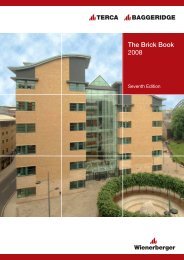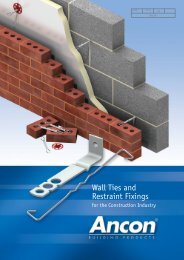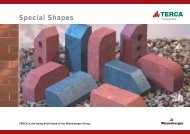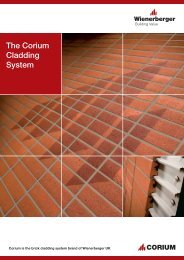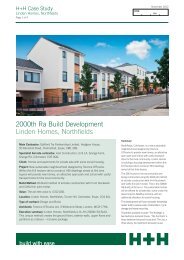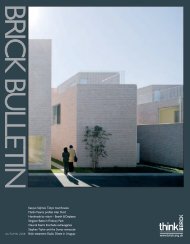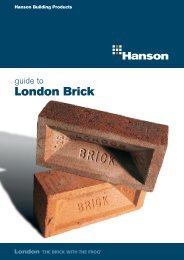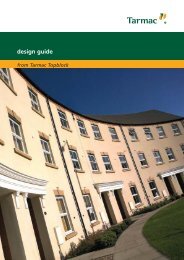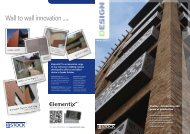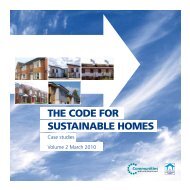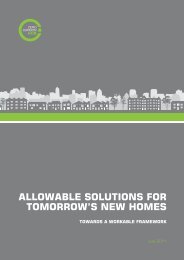Thermal Performance: Part L1A - Masonryfirst.com
Thermal Performance: Part L1A - Masonryfirst.com
Thermal Performance: Part L1A - Masonryfirst.com
Create successful ePaper yourself
Turn your PDF publications into a flip-book with our unique Google optimized e-Paper software.
<strong>Thermal</strong> <strong>Performance</strong>: <strong>Part</strong> <strong>L1A</strong>Measuring a dwelling’s overall thermal massSAP calculates a dwelling’s overall thermal mass by multiplying thesurface area for each construction element by its k-value and addingthe results. The total is then divided by the floor area of the dwelling togive the <strong>Thermal</strong> Mass Parameter (TMP) measured in kJ/m 2 K, where ‘m 2 ’refers to the dwelling’s floor area. Figure 10 shows what is considered inSAP to be low, medium and high levels of thermal mass. Figure 11 showsthe approximate TMP for a typical end terrace house built using a rangeof materials and finishes. It should be noted that the TMP varies to someextent with the size of dwelling.Figure 10: TMP categories in SAP.<strong>Thermal</strong> mass of dwelling TMP (kJ/m 2 K)Low 100Medium 250High 450Figure 11: <strong>Thermal</strong> Mass Parameter (TMP) for a typical end terrace house:HouseconstructionTimber ground floorConcrete ground floorStud partitionsBlock partitionsTimber upper floorConcrete upper floorApproximate <strong>Thermal</strong> Mass Parameter (kJ/m 2 K)50 100 150 200 250 300 350 400 450 500 550 600 650Timber frame 60-80Timber frame 90-120Masonry (600 kg/m 3 blocks) 160-220Masonry (600 kg/m 3 blocks) 190-240Masonry (600 kg/m 3 blocks) 250-370Masonry (1400 kg/m 3 blocks) 270-350Masonry (1400 kg/m 3 blocks) 340-420Masonry (1400 kg/m 3 blocks) 400-540Masonry (2000 kg/m 3 blocks) 340-430Masonry (2000 kg/m 3 blocks) 430-530Masonry (2000 kg/m 3 blocks) 500-650Effect of thermal mass on space heating in SAPDuring the heating season, SAP now takes some account of the wayin which thermal mass can store and later release heat gains from thesun and internal appliances, helping reduce fuel consumption and CO 2emissions.To realise this benefit in SAP, it is important that the:• Level of insulation and air tightness is to a high standard i.e. inaccordance with the FEES or better.• Boiler and heating controls are of a high standard.When these points are optimised in an end terrace house, SAP 2009shows a reduction in annual CO 2 emissions of around 3 to 4% when theTMP is changed from a low value of 100 to a high value of 450. In reality,savings may be more significant as SAP is not intended as a passivedesign tool.Effect of thermal mass on the overheating check in SAPThe overheating check is largely unchanged in the revised versionof SAP. Notable exceptions include the weather data which has beenupdated but does not, as yet, take into account likely future climatechange. Another change is that thermal mass, as represented by the TMP(see above) replaces the former admittance based approach, althoughthis makes little difference to the out<strong>com</strong>e. Moving from a low to highTMP will reduce the calculated peak internal temperature by about1.5 degrees in the overheating check. In reality, the reduction willoften be greater, particularly where adequate night-time ventilationis possible. Looking ahead, it is likely that the overheating check willbe revisited in line with re<strong>com</strong>mendations contained in a recentZero Carbon Hub report [15] that reviews the modelling tools andassumptions used for new homes. The report calls for an improvedoverheating test that adequately reflects the effects of both passiveand active design features and is based on projected future climaticconditions.12




